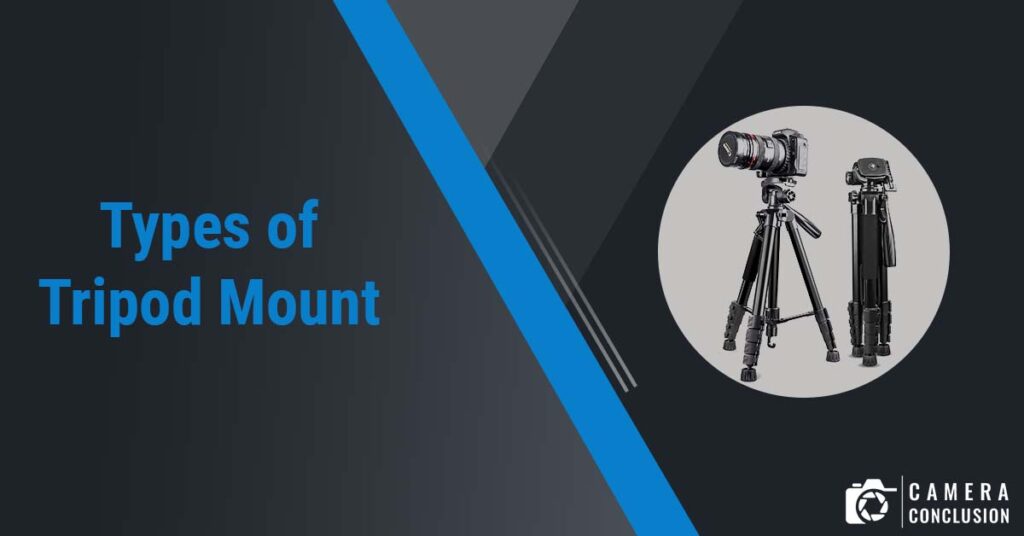Index [hide]
A tripod mount is a crucial component of any camera setup. It allows you to attach your camera to a tripod, stabilizing it and providing you with a steady shot. However, not all tripod mounts are created equal. There are different types of tripod mounts available, each with its own benefits and drawbacks. Choosing the right tripod mount for your camera can make a significant difference in the quality of your photos or videos. In this article, we will explore the various types of camera tripod mounts, their features, and their ideal uses.
Ball head
A ball head is a type of tripod head that allows for versatile movement and positioning of a camera or other equipment. The head of the ball head is a ball and socket design, which allows the camera to be positioned in a variety of angles. The ball is typically held in place by a single locking knob or lever, which can be tightened to keep the camera steady in a specific position.
Ball heads are popular among photographers because they are easy to use, and allow for quick and smooth adjustments to the camera’s position. They are also relatively compact and lightweight, making them easy to transport.
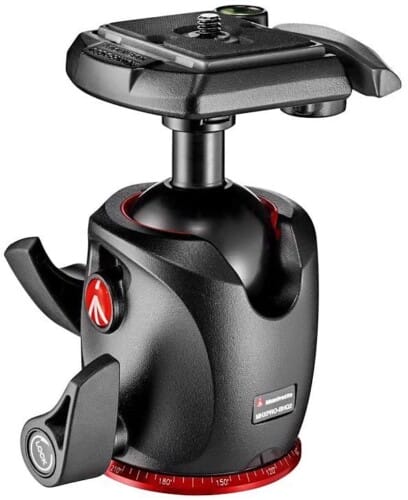
Ball heads come in different sizes, load capacity and level of precision, some are designed for heavy duty use and others for lightweight cameras, some of them have separate pan and tilt control, others have a single knob to control both.
One of the main advantages of a ball head is its ability to move the camera in any direction, and to position it at any angle. However, they are not as smooth as fluid head when it comes to panning or tilting, and they don’t have the same level of control over resistance and dampening.
Overall, a ball head is a versatile and easy to use option for photographers and videographers that need to quickly adjust the position of their camera, but for more precise and smooth movements a fluid head is recommended.
Pan and Tilt Tripod Head
A pan and tilt tripod head is a type of tripod head that allows for separate control of the pan and tilt movements of the camera or other equipment. The head typically has two separate handles or knobs, one for panning (horizontal movement) and one for tilting (vertical movement).
This type of head allows for more precise control over the position of the camera, as the pan and tilt movements can be adjusted independently of each other. This is particularly useful for tracking moving subjects or for adjusting the composition of a shot.
Pan and tilt heads are also known as “two-way heads” they are a step up from ball heads in terms of precision and control. They can be found in different sizes, load capacity, and level of precision, some are designed for heavy duty use and others for lightweight cameras.
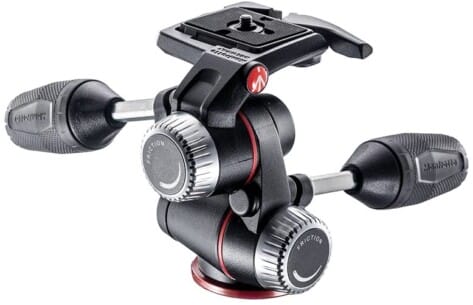
The pan and tilt head can be locked in place using locking knobs or levers for each movement, to keep the camera steady in a specific position.
However, like ball heads, pan and tilt heads are not as smooth as fluid head when it comes to panning or tilting, and they don’t have the same level of control over resistance and dampening.
Overall, a pan and tilt tripod head is a good option for photographers and videographers who need more precise control over the position of their camera, but for even more precise and smooth movements a fluid head is recommended.
Gimbal Head
A gimbal head is a type of tripod head that is specifically designed for use with long telephoto lenses. It allows for smooth and precise movement of the camera while keeping the lens perfectly balanced and stable.
A gimbal head works by using a pivot point and counterweights to balance the weight of the lens. This allows the camera to be moved freely in any direction without any strain on the tripod or the photographer’s arms. The camera can be easily repositioned and tracked moving subjects without any unwanted vibrations or movements.
Gimbal heads typically have separate pan and tilt mechanisms that can be controlled separately, and also have a locking system to keep the camera in a fixed position. Some gimbal heads also have a built-in system to control the resistance or dampening of the movement, which can be adjusted depending on the type of shot you are trying to achieve.
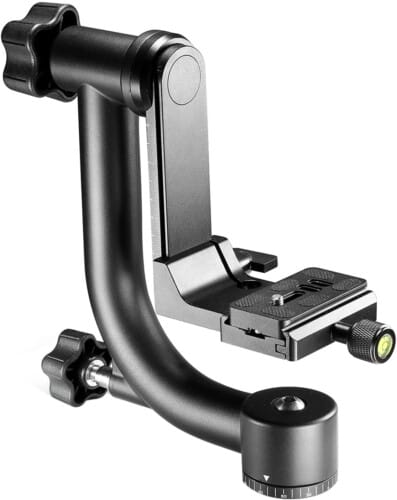
Gimbal heads are ideal for wildlife, sports, and bird photography where the photographer needs to follow the movement of the subject while keeping the lens steady and stable. They are also great for long telephoto lenses that are heavy and difficult to hold steady by hand.
It’s important to note that gimbal heads are not suitable for all types of photography, they are specialized tool that is designed to work with long telephoto lenses. They are also heavier and bulkier than other types of tripod heads, but for the right application, they can be a valuable addition to a photographer’s equipment.
Pistol Grip Head
A pistol grip head is a type of tripod head that is designed to be operated with one hand, using a trigger-like mechanism that allows for quick and easy adjustments to the camera’s position. The camera is mounted on top of the head and can be locked in place by squeezing the trigger.
The pistol grip design allows for fast and intuitive adjustments to the camera’s position, and it is particularly useful for tracking moving subjects or for adjusting the composition of a shot. It is also popular among photographers who need to quickly adjust the position of the camera in the field.
Pistol grip heads typically have separate pan and tilt mechanisms that can be controlled separately and a locking system to keep the camera in a fixed position. They also usually have a built-in bubble level to help keep the camera level and a quick release plate to quickly and easily attach and detach the camera from the head.
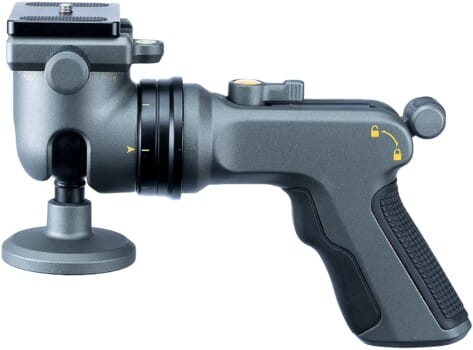
Pistol grip heads are lightweight, compact and easy to use, they are popular among wildlife, sports, and action photographers who need to be quick and precise when tracking a subject. They can also be useful for videographers who want to be able to move the camera smoothly and quickly without having to stop and make adjustments to the head.
It’s important to note that pistol grip heads are not suitable for all types of photography, they are specialized tool that is designed to work with one hand, and they are not as precise as other types of tripod heads, but for the right application, they can be a valuable addition to a photographer’s equipment.
Fluid Head
A fluid head is a type of tripod head that is designed for smooth and precise movement of the camera or other equipment while it is supported on the tripod. It has a special type of head that is filled with a fluid, such as oil or gel, that helps to create a smooth and consistent movement of the camera as it is panned or tilted.
Fluid heads are typically used in video production and live streaming, as they allow for smooth panning and tilting of the camera and provide more precise control over the movement than a traditional tripod head. They are equipped with separate pan and tilt mechanisms that can be controlled separately, and a locking system to keep the camera in a fixed position.
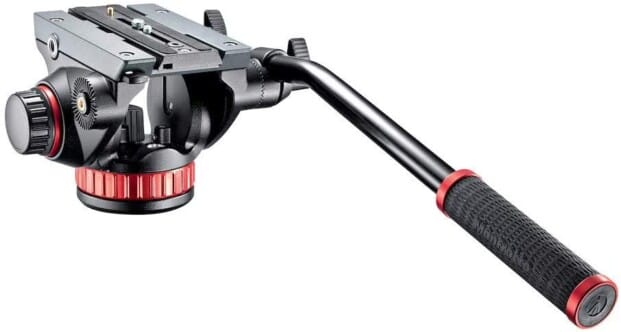
Some fluid heads also have a built-in system to control the resistance or dampening of the movement, which can be adjusted depending on the type of shot you are trying to achieve. This means that you can make the movement as smooth or as stiff as you like, which is particularly useful for video work or when you want to follow moving subjects.
Fluid heads are typically more expensive than other types of tripod heads and also heavier, but for professional videographers, and photographers who need smooth and precise camera movements, they are an essential piece of equipment.
Tilt Head
A tilt head is a type of tripod head that allows for vertical movement, or tilting, of the camera or other equipment. It typically has a single handle or knob that controls the tilt movement, and a locking system to keep the camera in a fixed position.
A tilt head is generally simpler in design and function compared to other types of heads such as ball head or pan and tilt heads. It allows for tilting the camera up and down, but not for panning or horizontal movement.
Tilt heads can be found in different sizes, load capacity and level of precision, some are designed for heavy duty use and others for lightweight cameras. They are also relatively simple to use, and easy to transport.
Tilt heads are not as versatile as other types of heads, they lack the ability to pan or horizontal movement, and they don’t have the same level of control over resistance and dampening, but they can be useful in certain situations where only vertical movement is needed.
Overall, a tilt head is a basic type of tripod head that allows for vertical movement of the camera, they are not as versatile as other heads, but they can be useful in certain situations where only vertical movement is needed.
Motorized Tripod Head
A motorized tripod head is a type of tripod head that is equipped with a motor that allows for smooth and precise movement of the camera or other equipment. It is typically controlled by a remote control or a computer software, which allows for programmed movements, time-lapse photography, and capturing panoramic photos.
Motorized tripod heads come in different types, some are designed for panning and tilting, others for panning only, and others for tilting only. They also come in different sizes, load capacity and level of precision, some are designed for heavy-duty use and others for lightweight cameras.
The motorized head can be set to move in a specific direction and speed, and can also be programmed to move in a specific pattern, this is particularly useful for time-lapse photography, where the camera needs to move in a specific way over a period of time, or for capturing panoramic photos where the camera needs to rotate around the nodal point of the lens.
Motorized tripod heads are typically more expensive than other types of heads and also heavier, but they offer a level of control and precision that is not possible with manual heads. They are also useful for situations where the camera needs to move in a specific way over a period of time, such as in time-lapse photography or when following a moving subject, and also for capturing panoramic photos.
Overall, a motorized tripod head is a specialized tool that allows for smooth and precise movement of the camera, they are useful in situations where the camera needs to move in a specific way over a period of time, for capturing panoramic photos and for achieving professional-looking videos and photos.
Three-way heads
A three-way head is a type of tripod head that allows for separate control of the pan, tilt, and roll movements of the camera or other equipment. The head typically has three separate handles or knobs, one for panning (horizontal movement), one for tilting (vertical movement), and one for roll (rotation around the lens axis).
This type of head allows for even more precise control over the position of the camera, as the pan, tilt, and roll movements can be adjusted independently of each other. This is particularly useful for architectural, landscape, and macro photography where the photographer needs to fine-tune the camera position and ensure that the camera is perfectly level.
Three-way heads are also known as “three-dimensional heads” they are a step up from pan-tilt heads in terms of precision and control. They can be found in different sizes, load capacity, and level of precision, some are designed for heavy-duty use and others for lightweight cameras.
The three-way head can be locked in place using locking knobs or levers for each movement, to keep the camera steady in a specific position.
However, like pan and tilt heads, three-way heads are not as smooth as fluid head when it comes to panning, tilting or rolling, and they don’t have the same level of control over resistance and dampening.
Overall, a three-way tripod head is a good option for photographers and videographers who need even more precise control over the position of their camera, but for even more precise and smooth movements a fluid head is recommended.
Panoramic Tripod Head
A panoramic tripod head is a specialized type of tripod head that is specifically designed for capturing panoramic photos. It allows for precise rotation of the camera around the nodal point of the lens, which is the point at which the light rays converge. This ensures that parallax errors are minimized, and the final panorama is stitched together seamlessly.
Panoramic tripod heads typically have a rotating base plate that allows for precise rotation of the camera around the nodal point of the lens. They also often have a spirit level and precise scale markings to help ensure that the camera is level and that the rotation is accurate.
Some panoramic tripod heads are motorized, they can be controlled by a remote control or a computer software and can be programmed to move in a specific pattern, this is particularly useful for capturing panoramic photos where the camera needs to move in a specific way over a period of time.

Panoramic tripod heads are typically more expensive than other types of heads and also heavier, but they offer a level of control and precision that is not possible with manual heads and are essential for capturing high-quality panoramic photos.
Overall, a panoramic tripod head is a specialized tool that allows for precise rotation of the camera around the nodal point of the lens, and it minimizes parallax errors in panoramic photos, it is a useful tool for photographers who want to capture high-quality panoramic photos.
